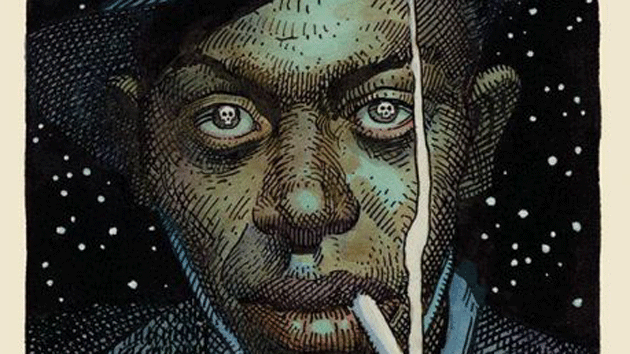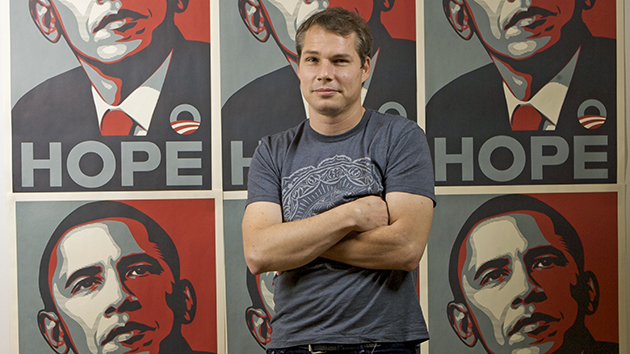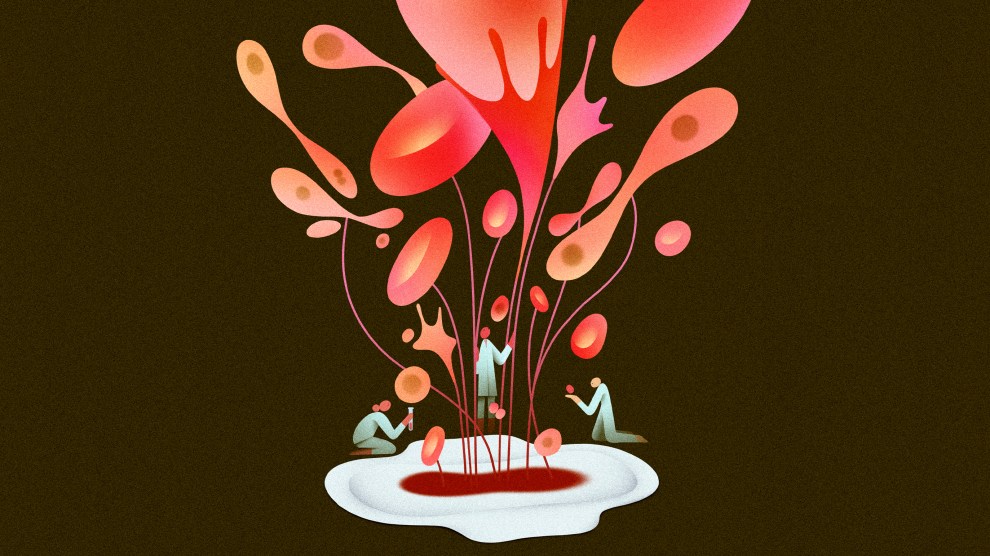Freelance illustrator Barry Blitt keeps folders and folders of Donald Trump photos on his computer—nearly 400 total, he says. “They’re pictures of him at strange angles, like from the back,” says Blitt, adding that Trump’s head looks like it is “sculpted out of some kind of pudding.” The current president, he says, makes for an endlessly fascinating muse. “I didn’t know anyone could look like that. He’s like an instruction manual for how to caricature.”
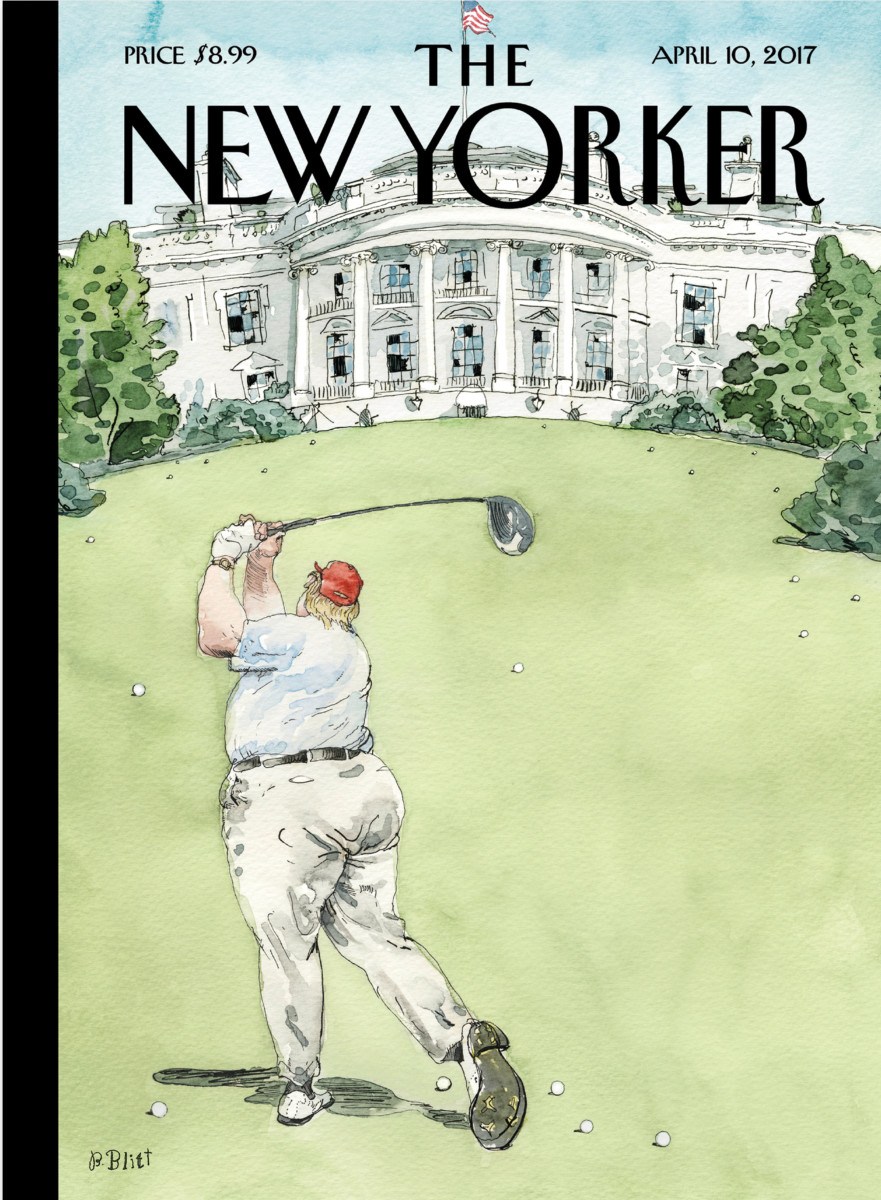
Born in Montreal, Blitt, 58, has been inking illustrations for the New Yorker since 1992 and has also contributed drawings to the New York Times, Vanity Fair, Rolling Stone, and Mother Jones. He has a knack for rendering political moments with dark humor, and the most recent presidential election has meant he’s busier than ever. His most recent cover took aim at President Trump’s frequent golf trips, showing the president lobbing balls at the White House’s shattered windows. Another cover offered a sly commentary on Russia’s influence on the election: Vladimir Putin takes the place of the magazine’s mascot, with Trump as a moth under examination.
As the reality sinks in that Trump will likely be a main subject for four more years, I talked to Blitt about capturing the president’s quirks, how he got his start, and learning to loosen up.
Mother Jones: You have a Connecticut number.
Barry Blitt: Actually I’m living in the house that Arthur Miller wrote Death of a Salesman in many years ago. Been here about a year.
MJ: Thank you for agreeing to talk. I’ve always loved your covers.
BB: Okay, well, we’ll see if you can get anything out of me.
MJ: I mentioned by e-mail that if I record our interview it’s not going anywhere outside a computer of mine.
BB: As long as it doesn’t turn up like that Milo interview or like Donald Trump’s infamous bus interview, then we’re fine.

MJ: As long as you don’t say anything about grabbing things, I think you should be good.
BB: Yeah, haven’t grabbed anything.
MJ: Just some pens and brushes I guess.
BB: I grab a lot of pens, yes. If that becomes controversial, then I’m in trouble.
MJ: Okay, here’s a softball: What brought you to cartooning and drawing?
BB: Like all kids I was plopped down in front of crayons and paper when I was quite young. My grandfather used to copy Norman Rockwell pictures, so I had him as a cheerleader. All my drawings always sort of looked funny even if I was trying to do serious stuff and express myself about grim situations. It was always cartoony.
MJ: What did you like to draw as a kid?
BB: I was drawing Popeye a lot. I was a big fan. A lot of the early work I did was sort of hero worship. I remember drawing a lot of hockey players—I’m Canadian. Hockey players and baseball players and Elton John and rock stars and stuff. Only in high school and college, I became more sarcastic and hostile.
MJ: How so?
BB: I felt it was more fun to knock people down than to build them up. I seemed to get a better reaction from my peers and from my friends when I was mocking stuff—which isn’t necessarily anything to be too proud of.
MJ: Did you aspire to be an artist?
BB: I guess for a while I thought I would be drawing caricatures in parks and stuff. I wasn’t sure what the hell I was going to do, actually. Cartooning didn’t seem like a real thing—it seemed like cheating. Letting a sense of humor into the process somehow seemed like an easy way out. I wouldn’t have to paint the Sistine Chapel if I could just make a joke that got a reaction—not that painting the Sistine Chapel was ever an option.
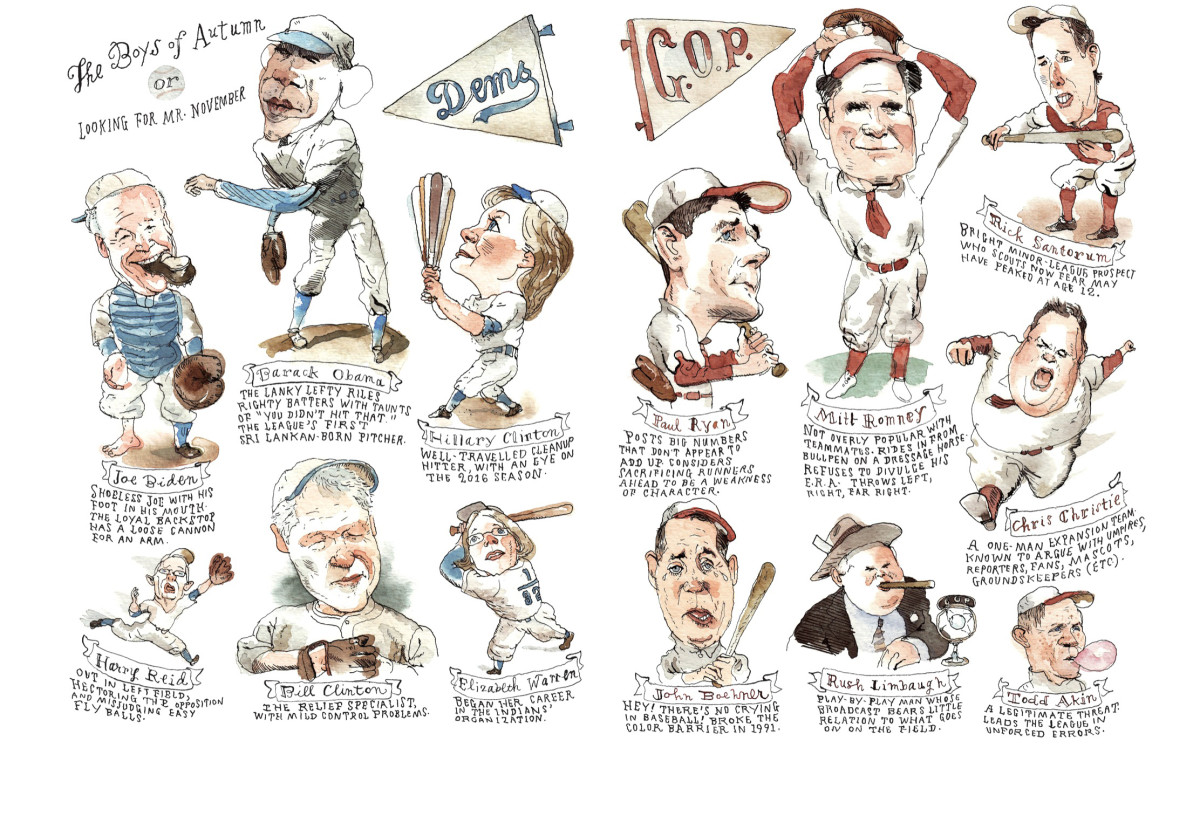
MJ: Do you remember the first piece that got published?
BB: When I was a teenager, I was a rabid hockey fan—I still am—and I ended up doing illustrations for a couple of yearbooks: the Philadelphia Flyers’ and the Pittsburgh Penguins’. I got those published when I was probably 15. A friend of mine, a kid in my 10th grade class, said, “I’ll be your agent.” He typed up a letter and sent it out to a bunch of hockey teams and a couple of them responded and I think I did drawings for $25 a pop and I gave him $5. I was totally full of myself. I thought it was the greatest thing.
MJ: Hey, getting hockey teams that you like to buy your drawings is a big deal at that age.
BB: It’s true. It didn’t help me with girls or anything, but it made adolescence a little less terrible.
MJ: Should we go into your adolescence?
BB: No. Let’s stay away from all of this.
MJ: That’s totally fine. I wasn’t a really great adolescent either.
BB: I’m 58 and I’m still recovering.
MJ: Tell me about your first big break?
BB: I was getting stuff published in Toronto and I made a couple of trips to New York and brought my portfolio. It was all pen and ink and attempted funny stuff. I went to see Chris Curry at The New Yorker. It all just sort of happened organically. I’m not a good businessman and I don’t promote myself particularly well. It’s best I don’t talk to anybody lest I alienate myself. Chris was an art director there and she was using some small drawings. When Françoise Mouly, the cover-art director, was brought on, Chris arranged for me to meet with her. I really didn’t think that I had the right sensibility to be doing New Yorker covers, but I was hired.
I was doing interior color drawings for Françoise. At the end of a conversation she just happened to mention, “You know, that smoker’s cover, the sketch that you sent us, why don’t you go ahead with that? Tina Brown accepted it.”
I guess if we’re looking for a big break, that was one of them, although it almost broke me. I get so nervous often with bigger assignments—I probably drew it 10 or 15 times, the final artwork. It took a lot of art direction to get it out of me. I think it was the first issue of 1994.
MJ: What was the picture?
BB: “Resolute Smokers.” It was right around the time when smokers had to go outside to smoke, and so I had a lot of smokers standing on window ledges on high buildings in New York, stepping outside to smoke. It turned out someone else had done that idea, not only in Time but in the New Yorker in one of their black and white cartoons some years before. Now we always check.
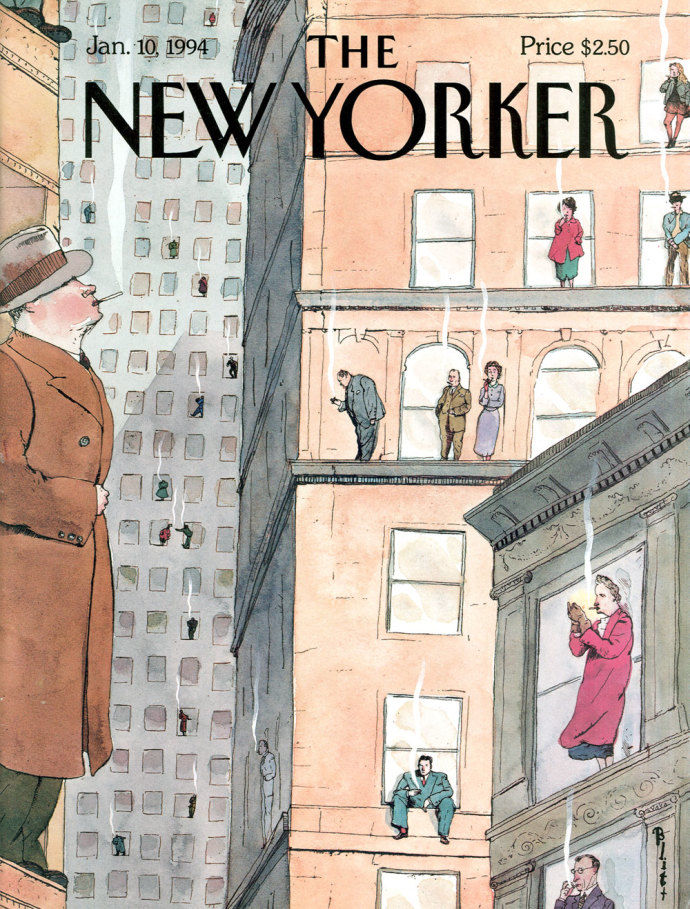
MJ: What was it like to get a cover?
BB: Very exciting. When I saw it printed I was sort of, like I often am, “Oh, why didn’t I do this?” or, “Why did I make that that color?” That’s pretty par for the course.
MJ: I think that’s something a lot of creative people feel.
BB: Yeah. It would be nice to be satisfied once in a while, though.
MJ: It sounds like you’re on the obsessive side. Are you a perfectionist?
BB: I’m an adequatist! I would be happy with something adequate. Perfection’s out of the question.
MJ: Do you work mainly for the New Yorker now?
BB: I work for lots of different magazines. I’ve done some kids books. The New Yorker is just about my favorite magazine and it’s incredibly nice to do a cover for them. You get a lot of feedback. When you do a bad one, it’s horrific. It’s a very visible kind of venue.
MJ: How closely were you following this past election?
BB: I was sort of obsessed with it, and living and dying with every new poll that came out. I have to say that I had the sick feeling Trump would win pretty much all the way through it. Even when it seemed like Hillary had it. I went to an election party that night and everyone was really cheerful and I just thought they were crazy. By 9:30 our time, I had to leave. I felt like I was like the one guy on the airplane that knew the plane was going to crash.
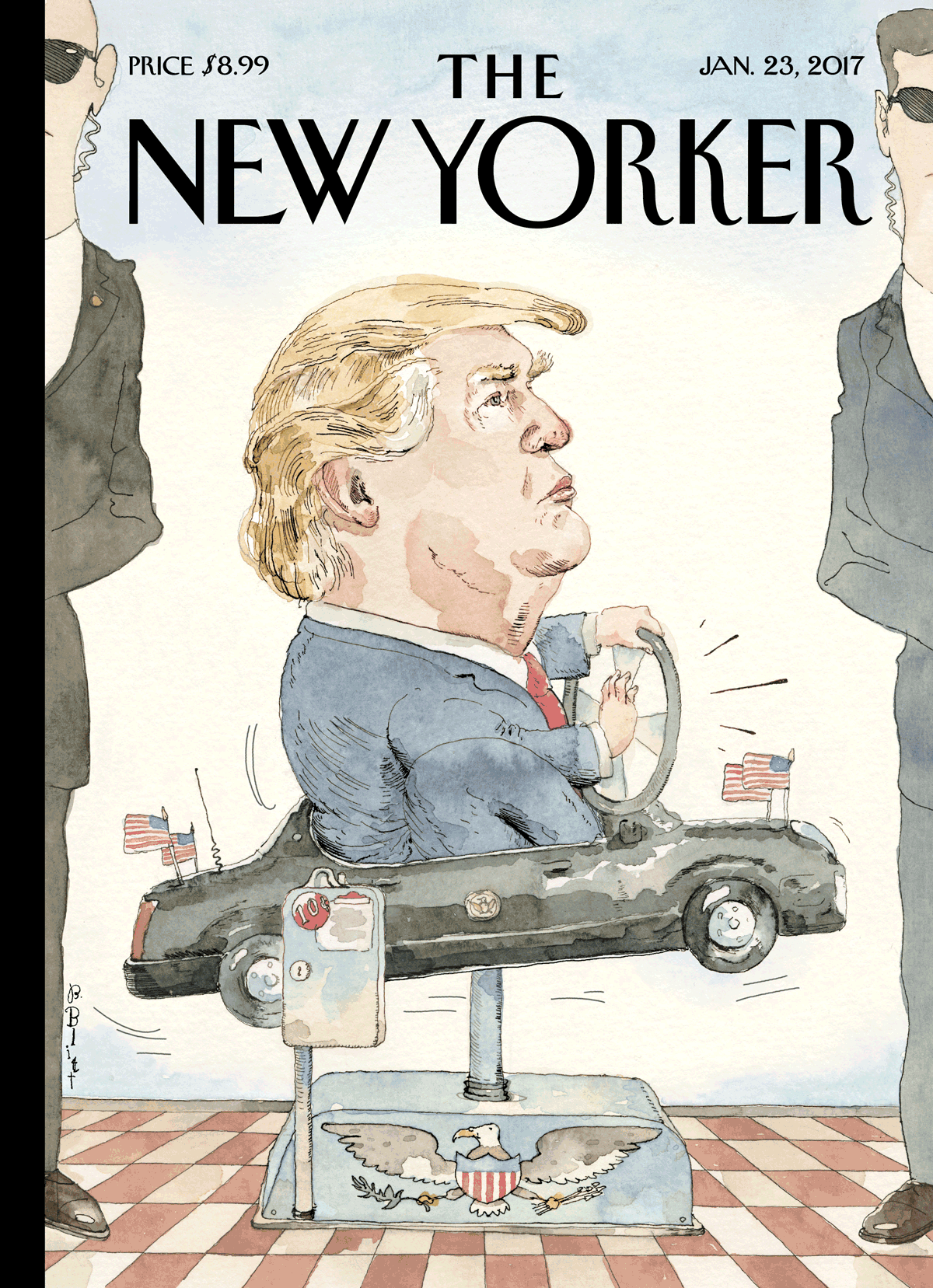
MJ: How do you approach the task of drawing Trump? Is there any feature that you focus on?
BB: When I’m online and I see a picture I want to draw of anybody or anything, a unique angle of them or just something that looks very drawable, I slide it to my desktop and put it in a folder. It just seems like every picture of Trump is a revelation. Any angle. I didn’t know a person could look like that. His facial expressions—he really is a cartoon. He’s like an instruction manual of how to caricature someone. I mean it’s just all there.
If you’re asking me what features—obviously his hair. The back of his head is fantastic and his eyebrows are amazing. His overbite and his series of chins and the color of him and the texture. It’s amazing! He’s like an artifact. It’s an amazing head to draw and I have to think it’s got to be part of his success. It’s ready-made for public consumption.
Just look at the back of his head, any angle. There’s some angles that his chin is just, what do I mean? I mean he’s sculpted out of some kind of pudding, I think. It looks like his face is sort of melting slowly. I should talk because my face is melting quickly. He’s some kind of bizarre sculpture. There’s no one really who looks like that.
MJ: How does that compare to Hillary?
BB: Hillary’s not un-caricaturable, that’s for sure. She’s got that mouth low on her face and her eyes are kind of wide apart. I’d be much happier drawing Hillary even if there were more challenges involved with getting a likeness. I’m not sure why we should even mention Hillary now. God bless her, but I don’t know. It feels like a ship that’s sailed.
MJ: I’d love to talk through the process for one of your Trump covers. Which is your favorite?
BB: If I tell you, you’ll see how shallow I am, because the favorite one I have would be the one where he’s in a little kiddie car. The flat watercolor that I got on his jacket, I like the way the color adhered to the paper.
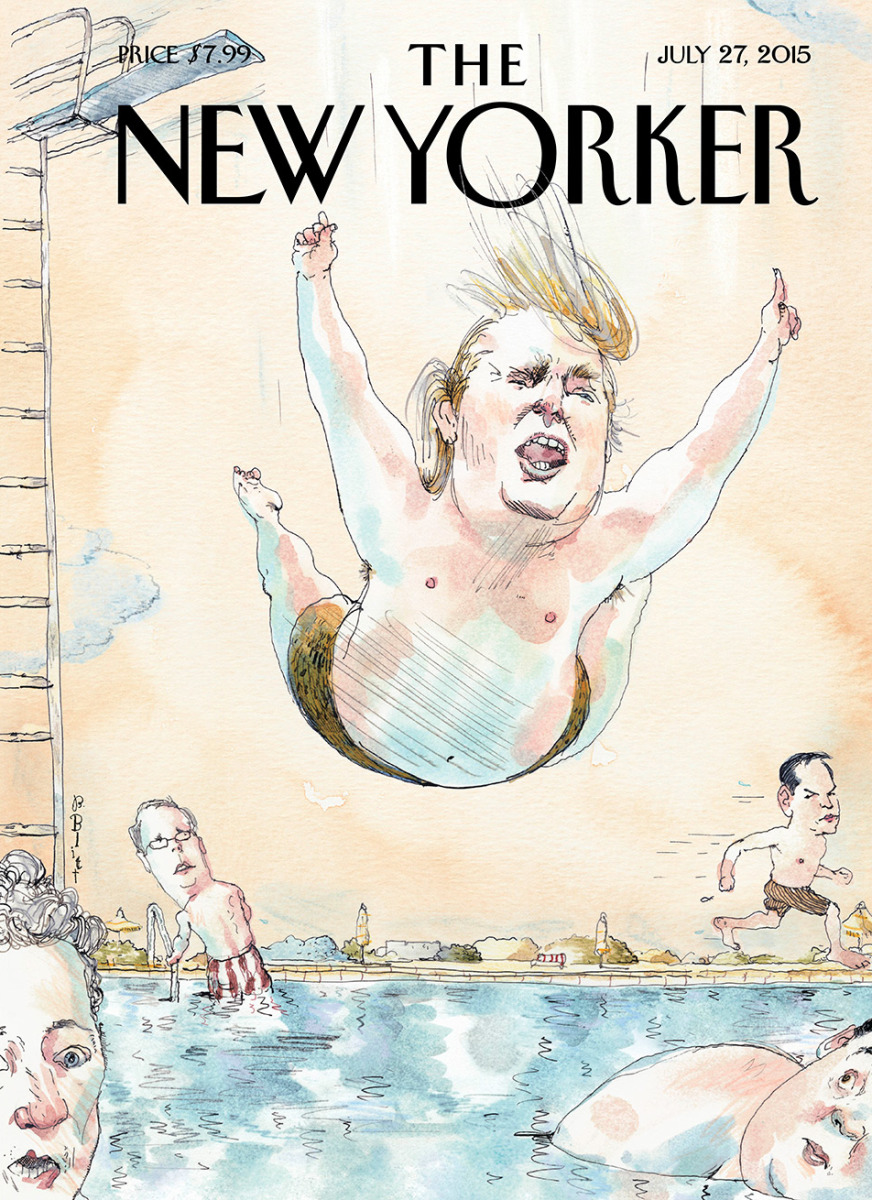
The first [cover I drew of Trump] was of him diving into a pool. You always remember your first. It just seemed crazy at the time that he was running and that it was actually happening and that he was insulting people. The whole thing seemed circus-like and crazy.
I remember doing a sketch of Hillary diving into a pool when she announced she was running. It was one of those diving boards where they have a secondary diving board and I had Bill on the lower board diving in as well, doing a flashier dive that was distracting from Hillary’s dive. That didn’t go, but I had that dive idea. Then when Trump started to make a splash I submitted a Trump. I remember it was him doing a cannonball. I think there was some reluctance on the New Yorker‘s part, if I’m remembering this correctly, to show him in any kind of triumphant or successful dive. Then I took that back and said, whatever, a belly flop, which suggests screwing up. That one they went with.
MJ: Tell me about your “Miss Congeniality” Trump cover.
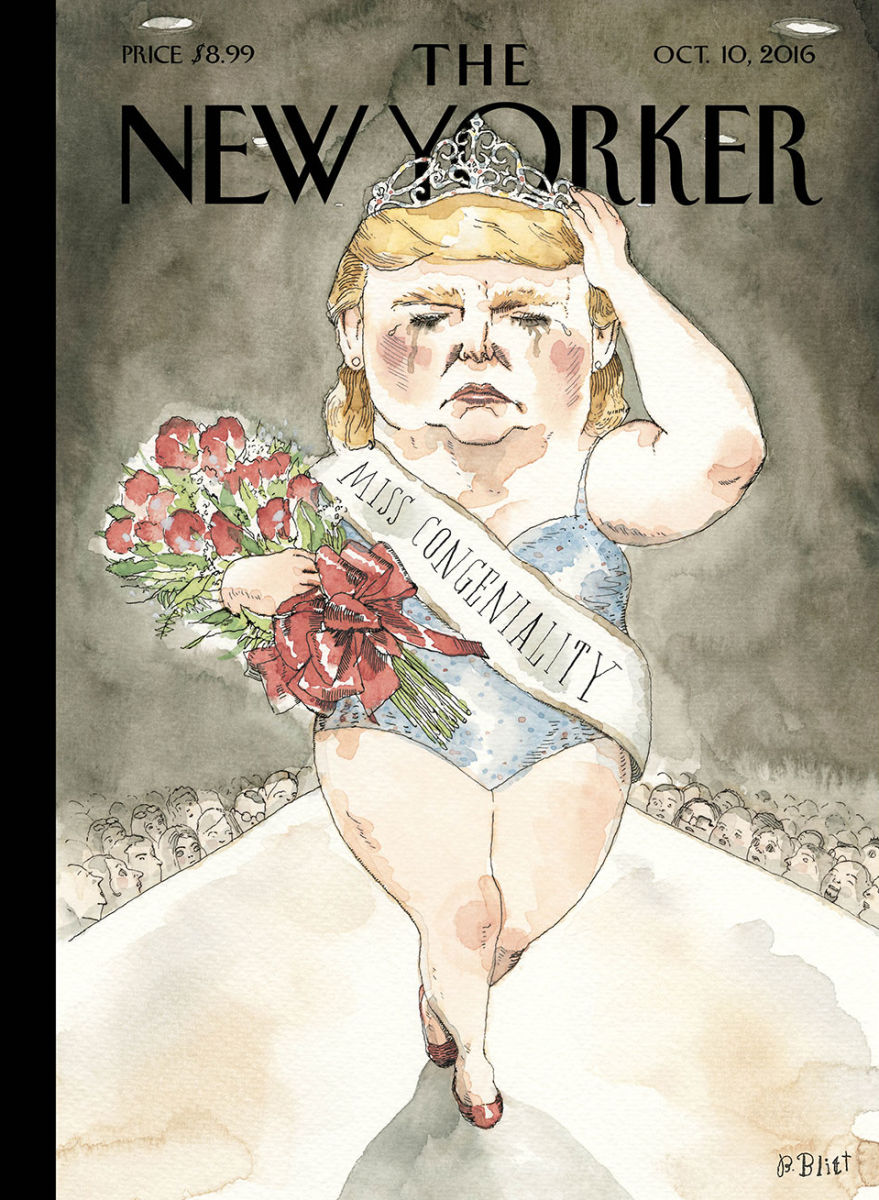
BB: A lot of people seem to like that one. I remember Hillary brought up that beauty pageant contestant whom he had openly mocked. It seemed like an interesting way to draw him.
I don’t remember how I arrived at that during the panic that’s involved sometimes when I’ll get a call from Françoise looking for an idea: “It would be great to do something about Trump” and whatever catastrophe happened last night or this afternoon. I will get into a state of panic and scribble things and send things and somehow what I’ve sent is legible enough and the ink isn’t smeared with my tears and she’s able to see what I’ve sent her and they’ll choose something and I’ll redraw it as properly as time allows.
MJ: Let’s talk through just one more cover. The “Anything But That” cover from before the election.
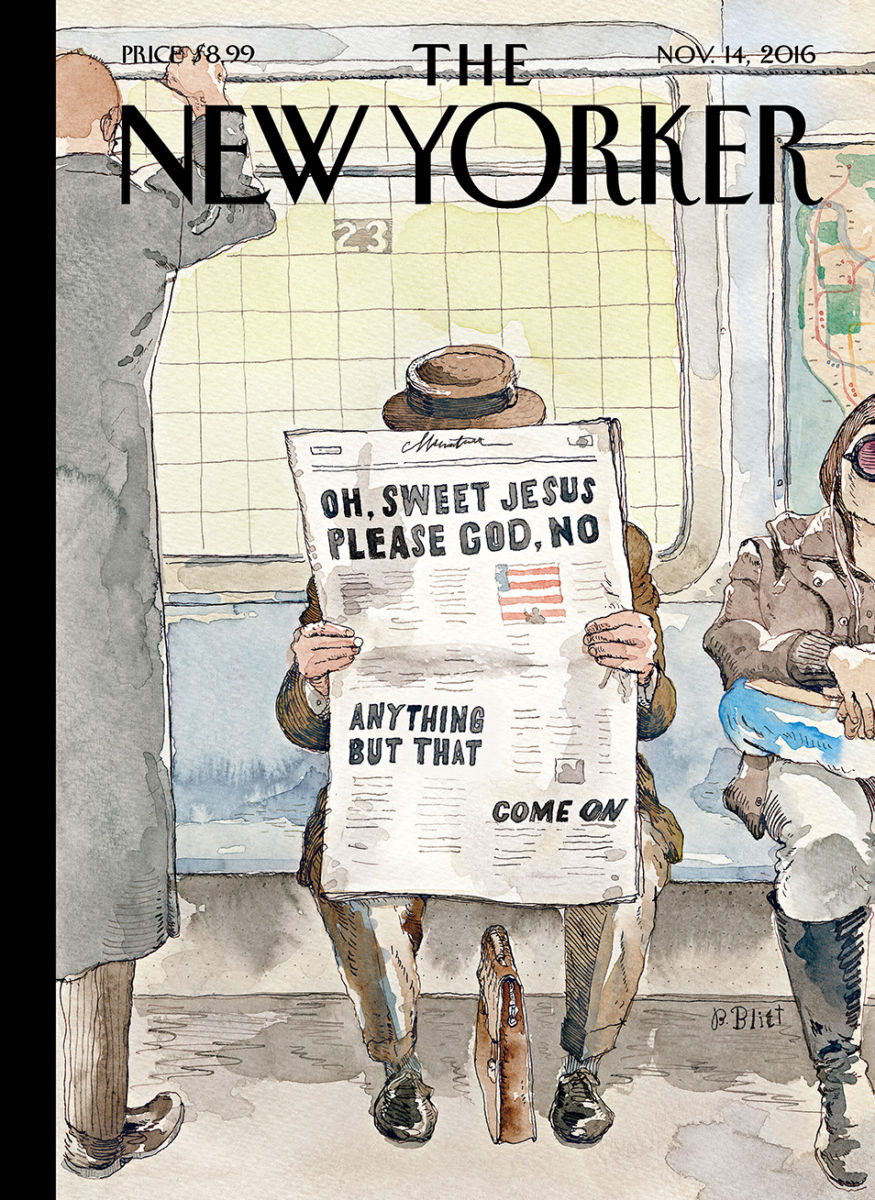
BB: I remember Françoise getting in touch with me and saying we still don’t have a cover for our politics issue, which is the issue that comes out the day before the election, kind of odd timing.
Hillary’s going to win—obviously—but we can’t really show that yet. It was sort of nice to not draw either of them. I think I had one of Uncle Sam watching with a remote in his hand. You don’t see the television and he’s reacting to what’s going on on the TV. I was sending in those kind of ideas, ones that didn’t favor or even show either candidate. It seemed funny to write headlines that obviously you’d never see, headlines of reaction and dread. I have friends who are right-wing. Most of my friends are not, but all of us were dreading the results of the election. The dread was built into this election—a little spoonful of dread. What was behind it was that it could work no matter who won. Someone pointed out to me that it looked like the person sitting next to the main figure was carrying a parachute and had a pilot’s, not a helmet, on, which really makes me laugh. I wish I had done that intentionally—they were about to leap.
MJ: What it’s like to look back on that cover now or to look at the cover the day after the election?
BB: After the election, I don’t think I was looking at that cover. I was looking at my Canadian passport, was what I was looking at. This was the first election I got to vote in also. I became a citizen a couple of years ago.
MJ: Wow, congratulations!
BB: Thanks. What was it like to look back at the cover? I’ll tell you what I always say, I wish that my verticals had lined up with it more and I wish that yellow of the background subway station had a little less line in it.
MJ: Do you think you’ll ever get tired of drawing Trump over the next four years?
BB: Yes, I probably will. I mean I’m already tired of the bullshit and not just the lying but the way he’s covered. It really seems like a low point. I’m sure this era will be remembered for a long time if there’s still time after it. Just as far as drawing him, that almost seems like the least of it. I’ve been thinking of trying to de-caricaturize him. I thought it would be fun to try and, since he’s already a caricature, to make him normal looking. I don’t know if I’ll get tired of him. It depends what he’s got in store. I don’t know how long it will be either. I don’t know how much more of this he or any of us can stand.
MJ: Maybe he’ll get a haircut.
BB: That’ll never happen!
MJ: I wanted to ask about the 2008 cover with Michelle and Barack Obama.
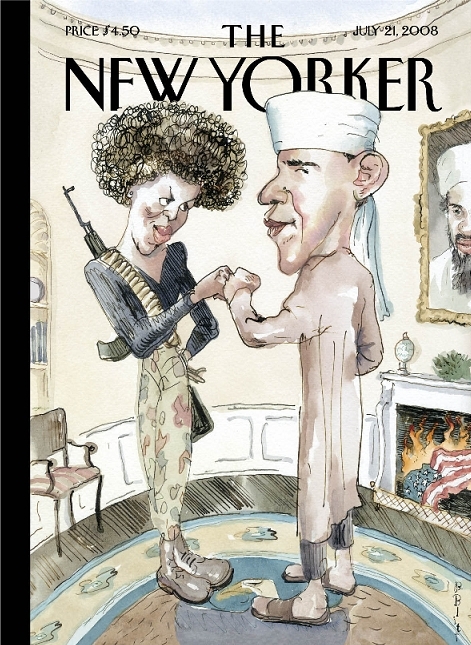
BB: Mm-hmm.
MJ: A lot has been said around that but what do you think about it now, and has it changed anything about your approach to drawing political cartoons since then?
BB: It probably changed my approach for the first few days it was on newsstands. It sort of freaked me out, but not anymore. I’m still sending crazy stuff that I can’t always justify necessarily. That one attempted to be satire. I can see how people were upset by it but I knew what I was trying to do and so did the New Yorker. It was an attempt at satirizing a voice of someone who wasn’t there, who wasn’t in the picture. I don’t know if it worked or not, but on to the next one.
MJ: Speaking of going on to the next picture, I saw that you’re doing a retrospective of your work.
BB: I do, I have a book. I got a deal but I can’t say deal without thinking of Donald Trump. I’m doing a book for Riverhead. I’m putting together all my years of drawings.
MJ: What does it feel like to look over all of your work?
BB: It’s kind of horrifying, but it is what it is. Some of them are worse than you remember, some are better than you remember. It’s hard to pick a representative number of them. My deadline is around now and I’ve not been feeling well and I’m sure it’s psychosomatic. As soon as I hand the stuff off I will feel better.
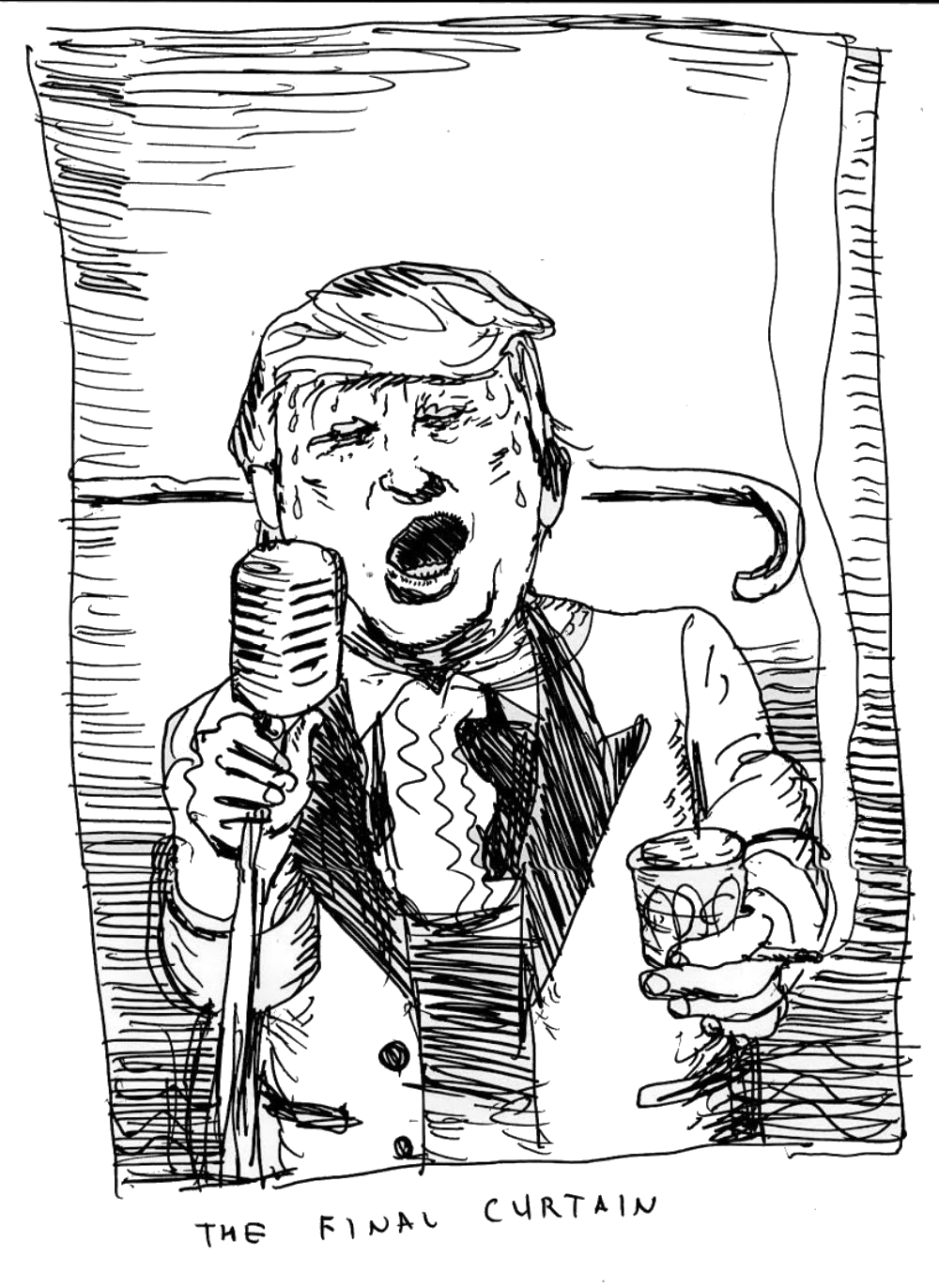
MJ: I definitely understand the psychosomatic thing. Happens to me too. Do you feel like you’ve noticed anything about yourself or your drawings when you look back at them over many, many years? Do you feel like you’ve changed?
BB: I see stylistic things. I learned that I wish I had learned more. I look at some drawings and I see I was attempting to try and be too loose and then other ones, I guess I get hung up on the stylistic side of things and the execution of the drawings.
As far as the process, I did one cover of Hillary Clinton as a fighter when she secured the nomination. I was able to sort of document in the book how that got away from me. The very first sketch I did, I made her look, not literally like a bulldog, but like a battle scarred veteran. She’s in the ring, sitting in her corner and she’s got a black eye and she looks toughened as hell. Then you see as it progresses to a tighter sketch she starts becoming a little cuter and more svelte. There was also an issue of not making her look like a battered woman that I suppose played into it. By the end of it the drawing was far too cute and it didn’t express what the first sketch was. If you can learn to convey what you express in the first rough sketch, you’re really saying what you need to say in that.
MJ: It seems like learning to trust your initial ideas is something that takes time.
BB: Right. If only, because that’s where the storytelling is, I think. I think I just learnt that now talking to you.
MJ: Oh really? What do you mean?
BB: I mean you forced me to consider what the hell I’m doing with this book. That’s what I would learn most if I would look at everything that I’ve put together. The choices for the stuff that go in the book weren’t just mine. There was an art director and a designer and editor involved. They chose a lot of sketches. We’ve got a couple of spreads of just 32 Trump attempts, attempts at Trump ideas that didn’t go anywhere. There’s probably more interesting ideas there than necessarily one finished drawing.
MJ: I always like going to retrospectives at the museum because you really do see how things move or how ideas change. I think that thinking about processes or seeing someone’s process is just very fascinating.
BB: Yeah, especially if you’ve already seen the final art. It’s incumbent on me to try and learn something from that, though.
MJ: You might get a flash of brilliance at the end.
BB: I might get a flash of self awareness, and we don’t want that.

MJ: Who are some artists you admire? Where do you find inspiration or what are some things that you love, that you really enjoy?
BB: I love Steve Brodner‘s work and I love John Cuneo‘s work and I love Ed Sorel‘s work. And Edel Rodriguez, Joe Ciardiello, and Anita Kunz. Where do I get inspiration? I like John Oliver and I’ll see clips of Stephen Colbert and the Daily Show. Bill Maher. I go to right-wing sites as well, as hard as that is to stomach sometimes.
MJ: What do you love about your work?
BB: I like to make myself laugh. When I’m just sitting with a sketchbook and trying to make myself laugh or trying to come up with ideas, I try not to worry about aim right away. I’m just sort of shooting in all directions.
I will sometimes scribble things no one should ever see. Several ideas for the New Yorker, I’ve had conversations with Françoise after I’ve sent her some sketches and she doesn’t like what I’ve sent her and she said, “You didn’t have any more?” I say, “Well you know, there are a couple of other things I’ve thought of but you don’t want to see them, believe me.” She’s really an advocate for not self editing and she’s got it out of me. A couple of times things have made it to the cover, just things I thought, “There’s no way that they would do that.”
If you’re asking me what I love, it’s that point where I’m just scribbling and trying to make myself laugh and trying to outrage myself. Getting in that frame of mind where the more you laugh the more you laugh—I think that’s what I’m attempting to do. It’s just like loosening up basically.
MJ: Do you ever have someone that you show your pictures to as a base?
BB: You mean like a sounding board? Sometimes my wife, but not always. Sometimes I get precious about ideas and I’ll send them to the New Yorker first. But I can be a little precious about them sometimes. You show it to someone and if they don’t get it right away or it’s not legible and you have to explain it, then you lose confidence in it. I’m very neurotic, let’s just come out and say that, about the process. I just don’t trust myself or anyone else. That sounds healthy, huh?
MJ: No, I understand. I get really neurotic with my stories. I should send them out to more people but I protect them, like little babies.
BB: Good. Don’t send this one to anybody!

